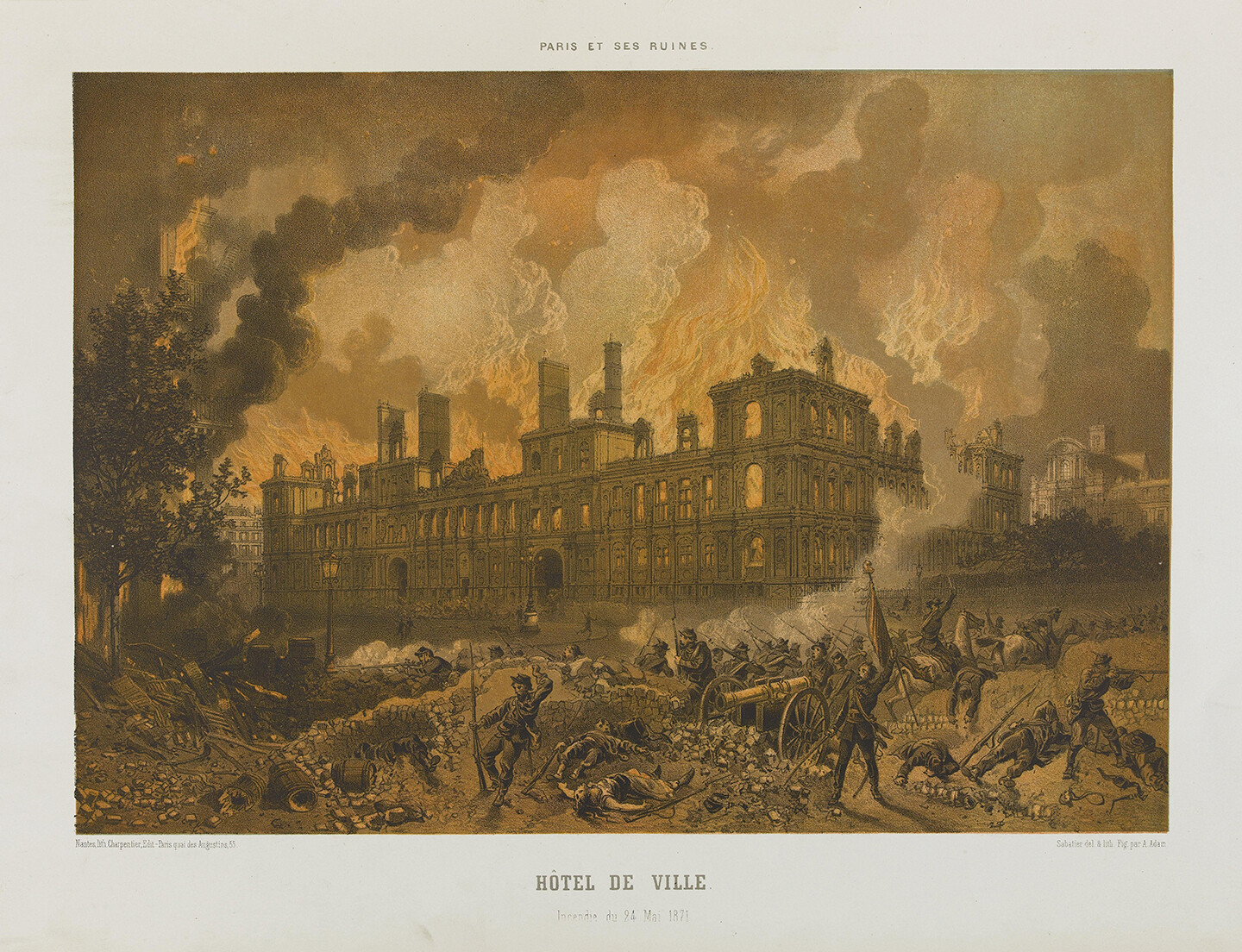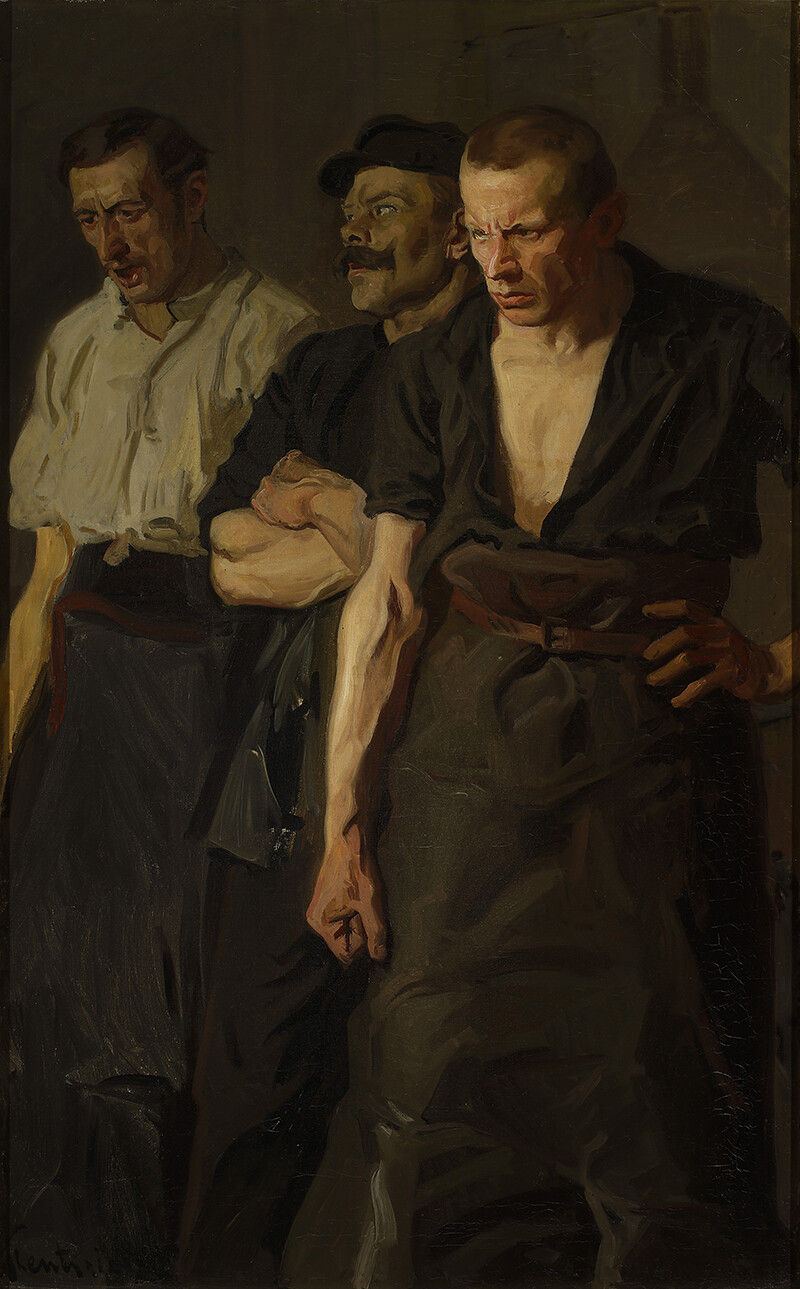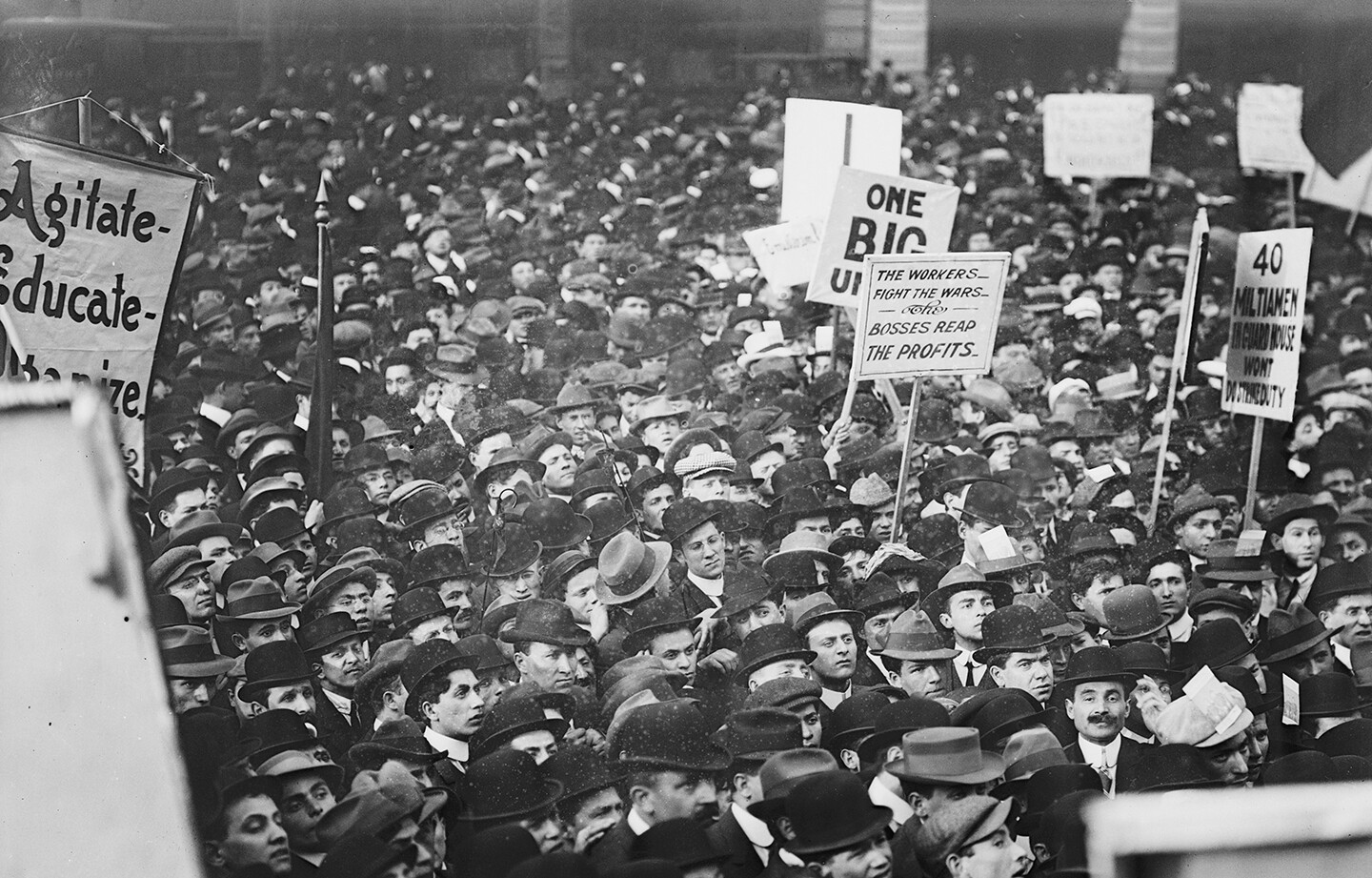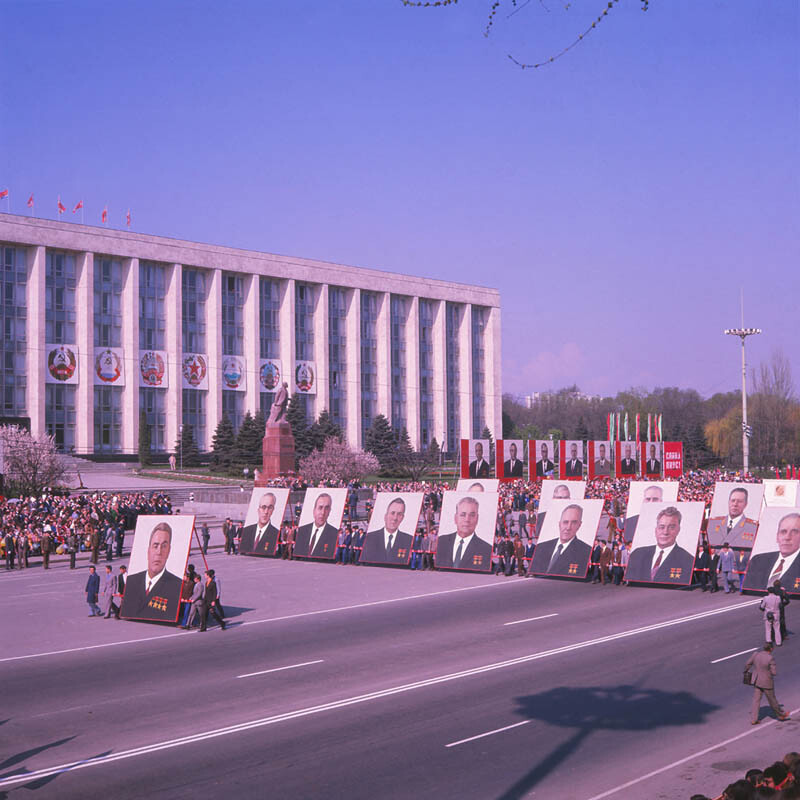As “thoroughly expansive” forms whose potential remained unactualized, the Commune of 1871 and the workers’ councils of 1917–23 hail from the future. When Rosa Luxemburg, Jan Appel, or Grandizo Munis call for the establishment of workers’ councils from the midst of a revolutionary sequence they still rate capable of succeeding, they look to an immediate or slightly more distant past and see in it a form able to open the doors to the future. This has the effect of making the theory of the commune both retrospective and prospective at once. For what the partisans of council or commune see in the past is not an actuality but a potential—not a program to be realized but a series of logical requirements and concomitants to be navigated.
The commune and the council show us what is eternal about revolutionary struggle against capitalism—what will always remain true insofar as capitalism and its problems persist. It remains as true today as it was in 1871 that “the working class cannot simply lay hold of the ready-made state machinery, and wield it for its own purposes.” Likewise, it remains true that “Paris could resist only because, in consequence of the siege, it had got rid of the army, and replaced it by a National Guard, the bulk of which consisted of working men.” What Marx describes as the “first decree” of the Commune—“the suppression of the standing army and its replacement by the armed people”—is actually a precondition of any revolution, realized by the precipitating events of 1871 and ratified after the fact. Only where war, chaos, or crisis has rendered the army intractable to state power do we see the real possibility of communist revolution. This doesn’t mean that all aspects of revolution can be deduced logically, but an understanding of what is contingent in revolution requires an understanding of what is not.


Fire at The Hôtel de Ville, the headquarters of the Commune, attacked by the Versailles Army and burned by the National Guard byLéon Sabatier, 1873. License: Public Domain.
At stake here is as much a method for reading history as for reading Marx. Key parts of the history of past revolutions as well as the pages of Marx’s Capital—and much other revolutionary theory—are illegible except by the light of a communism seen as inevitable, both historically and logically certain. This has the effect of making Marx appear most grandiose where he is in fact most modest. In 1868, he writes of the just-published Capital, his critique of political economy, that it is “without question the most terrible missile that has yet been hurled at the heads of the bourgeoisie.”1 “Heads,” here, confines his work to the field of discourse. Marx could devote himself to critique, in other words, to sinking the supply ships of bourgeois economics, precisely because he did not think such work determinative in matters of class war. He would hurl books at the heads of the bourgeoisie while the proletarian movement took out their legs. Take, for example, his letter to his longtime friend and supporter Louis Kugelmann, who wrote to Marx immediately after the original publication of Capital in German to report that readers familiar with economic theory were struggling with Marx’s theory of value. Marx responds:
The vulgar economist has not the faintest idea that the actual everyday exchange relations need not be identical with the magnitudes of value. The point of bourgeois society consists precisely in this, that a priori there is no conscious social regulation of production. The reasonable and the necessary in nature asserts itself only as a blindly working average.2
The bourgeoisie and its intellectual representatives are therefore forced to treat as “great discovery” the fact that “in appearance things look different.” They have no need for Marx’s “science” and in fact their standpoint in society will make it difficult to comprehend very simple matters: “The nonsense about the necessity of proving the concept of value arises from complete ignorance both of the subject dealt with and the method of science. Every child knows that a country which ceased to work, I will not say for a year, but for a few weeks, would die.” The problem in other words is not so much that Marx is very smart but that bourgeois economists are particularly stupid—their reaction “shows what these priests of the bourgeoisie have come to, when workers and even manufacturers and merchants understand my book and find their way about in it.” Notice the emphasis: even manufacturers and merchants can understand it, but workers do so more naturally. If his critique of political economy is a missile lobbed at the heads of the bourgeoisie, it is not undertaken to explain capitalism to them through the percussion of intellectual missiles—it is a critique on behalf of the working class, who pushes the attack on other fronts.
It is not because workers are better educated about the principles of economics that they intuitively understand Marx’s work. Rather it is because the experience of exploitation and oppression daily reminds them of the coherence and correctness of Marx’s critique, the necessity of revolution. What he says of “every child” is likely not true of bourgeois children, for whom the products of labor appear as if by magic; but proletarian children, who begin work young and watch their families work, do understand such basic matters. At stake is more than experience, however, but also attitude, standpoint—Marx’s Capital is always illuminated by a future communism. Once the “inner connection” between value magnitudes and exchange relations “is grasped,” he tells Kugelmann, “all belief in the permanent necessity of existing conditions breaks down before their practical collapse.” This first collapse, the critical collapse, is neither cause nor precondition of the practical collapse in crisis or revolution. Marx does not believe that by proving capitalism impermanent he will induce the bourgeoisie to simply quit the field. Indeed, he has noted they will find it constitutively difficult to descry their doom in the fog of the business cycle. Marx in 1865 is tribune of a workers’ movement that has already announced its historical mission: to abolish capitalism. It is not that Marx can kill capitalism with his ideas, but that he has expressed in ideas a movement already underway, one which seemed certain to usher in a practical collapse. The point of the critique of political economy is not so much ideology critique as it is an illumination of existing conditions in light of their practical collapse, on behalf of and for the movement that will precipitate it.
Marx wrote a book entitled Capital, not one entitled Communism or The Proletariat, because the workers’ movement did not need its ends articulated, did not need an explicit description of classless society, that common horizon. It needed better weapons, a clarification of means. At stake here is less a claim about Marx’s method than one about the methods which communists should use to read Marx. We can no doubt treat Capital as a grand analysis without presuppositions, an immanent critique, a science, a research project, but certain key aspects will remain inscrutable, written in invisible ink that only the heat of communism can bring to the surface. I think this is the case for important parts of Marx’s theory of value. As Marx notes in the letter, the bourgeoisie need hardly bother with the concept of value. They can make do with appearances. If proletarians understand the concept of value more readily it is because value names for Marx the inner coherence of that monster which proletarians recognize as their enemy. Value names the differentia specifica of the capitalist mode of production, the one element that presupposes all the others, the ring that binds together, the other rings of money and wages, profit and price, property and the police, the state and the banking system, world markets and international conflict. The concept of value is as much a descriptive concept as a revolutionary hieroglyphic, a critical heuristic designed to focus those who would overthrow capitalism on the essential.


Stanisław Lentz, Strike, 1910. National Museum in Warsaw. License: Public Domain.
These objectives are clearer in Marx’s first attempts at critique of political economy, where Marx generally had very particular political interlocutors in mind. Early anti-capitalists such as Pierre-Joseph Proudhon and his disciple Alfred Darimon, on the one hand, and the “Ricardian Socialists” like John Francis Bray, John Gray, and Thomas Hodgskin, on the other, frequently proposed to right the wrongs of capitalism through reform of the money system and banking.3 Marx recognized the incoherence and impracticability of these reforms—which mostly consisted of proposals to replace national and bank money with “labor money”—and it was in developing concepts adequate to these critiques, first in the Grundrisse and then in A Contribution to the Critique of Political Economy, that Marx struck on key aspects of his theory of value.4
Labor money was in many respects a derivation from the labor theory of value developed by Adam Smith and then David Ricardo. In the 1820s and 1830s in Britain, as resistance to early capitalism took shape in the form of trade unions and cooperatives, social reformers associated with Robert Owen and then Chartism developed the labor theory of value (LTV) into a theory of exploitation depending on natural rights and natural prices, cast in absolutist moral terms.5 Once it had been demonstrated that labor is the source and measure of all wealth, it required only a simple step further to propose to right the injustices of capitalism by denominating goods in terms of their “real” or natural value. With the prices of goods labeled in terms of labor hours and labor minutes, rather than dollars and pennies, it would be nearly impossible to swindle workers and not give them the full value of their product, according to proponents of the theory. The LTV thus offered both a critique of capitalism and a way to improve it, subordinating money and capital to the benefit of laborers and, in turn, the nation. Every monetary exchange could be made equal and transparent, with its real value for a producer written right there on its face.


Socialists in Union Square, NYC, 1 May 1912, by Bain Coll. Collection: Library of Congress. License: Public Domain.
Marx eventually refuted this by demonstrating that such a notion of fair exchange was self-contradictory: the very idea of equal exchange presupposes inequality, as he shows, because the value of labor (the output of a worker) is never the same as the value of labor power (the reproduction requirement of that worker, and therefore the price of its use by a capitalist). From this distinction, Marx develops one even more fundamental, between concrete labor and abstract labor, the core of his mature theory of value. His main achievement in this arena was not, as is sometimes supposed, a theory of surplus value or a proof of exploitation—versions of such a theory were already available, as he would summarize in the manuscript entitled Theories of Surplus Value. As Diane Elson formulates it elegantly in her seminal essay “Value: The Representation of Labor in Capitalism,” summarizing debates on the topic in the Conference of Socialist Economists in the 1970s, Marx’s theory of value had been radically misunderstood by those who saw in it a method to calculate the magnitudes of exploitation: “It is not a matter of seeking an explanation of why prices are what they are and finding it in labor. But rather of seeking an understanding of why labor takes the forms it does, and what the political consequences are.”6
Elson worries overtly in her introduction that her corrective reading, distinguishing between Marx’s theory of value and the Ricardian LTV, might be depoliticizing. For the Ricardian proof of exploitation, with or without labor money, at least had the virtue of being politically salient and leading to very clear practical objectives. This is because, despite the power of her corrective reading, she does not see how the concept of value is directly connected to the objectives of communism, naming not only a historical process—“why labor takes the form it does”—but a great misfortune, understanding of which will aid in its overcoming. Elson stands at the headwaters of a new way of reading Marx, begun in the 1960s and 1970s, with the publication of Marx’s complete works, and sometimes called “value-form theory” or, with respect to German exponents, the “new reading of Marx” (Neue Marx-Lektüre). These Marxological interventions have been enormously clarifying for readers of Marx, making sense of the inner analytic coherence of Marx’s work. This clearheaded way of reading Marx has, however, come at the expense of a certain political power, I would argue. It is a way of reading Marx for an era that lacks Marx’s certainty.
I will suggest another, complementary way of reading Capital, in which Marx’s masterwork is not only the adequate representation of the capitalist mode of production but an outline in negative of its overcoming by communism. I have come to this way of reading Marx by a long and winding route, over terrain that will be mapped thoroughly, though its origins lie in the programmatic method of Amadeo Bordiga, for whom, to use Gilles Dauvé’s helpful paraphrase, “the whole of Marx’s work was a description of communism.”7 Bordiga is supremely attentive to those moments in Marx’s mature writing, surprisingly abundant if you know what to look for, where in order to illuminate some feature of capitalism, Marx finds that he must, in fact, compare it with a fictitious communism. “Let us finally imagine, for a change, an association of free men, working with the means of production held in common and expending their many different forms of labor power as one single social labor force.”8 This is offered as ultimate contrast with capitalism, where the fetishism of commodities induces a complicated situation in which humans become mannequins puppeted and ventriloquized by sarcastic commodities, both unfree and deluded about the sources of their unfreedom. The purpose of such contrast is to bring out key features of the capitalist mode of production and class society more generally, otherwise untheorizable. It is only in the light of communism that we come to see the misprisions of the commodity form for what they are: “The veil is not removed from the countenance of the social life-process, i.e., the process of material production, until it becomes production by freely associated men, and stands under their conscious and planned control.” Marx therefore offers more than a description of capitalism, but one in which key predicates of communism become visible.
At stake here is less a claim about Marx’s method than the method that communists should apply to the reading of Marx. For communists, the science of capitalism is the theory of the rules of a game they hope to consign to the dustbin. The goal for us is neither just to enumerate those rules nor to learn to play the game better, but to develop from them an understanding of how the game itself might be overcome. If it is anything for communists in the twenty-first century, it is an applied science, the science of destroying capitalism, whose descriptions of capitalism and predictions about class struggle and its unfolding have their meaning in action, in class struggle itself. And here our concern should be less about what Marx intended—science of capitalism? weapon against it?—than what we, as communists, need. We need to know what capitalism is, but not in order to wonder at it and enumerate its sublimities. The concept of value is nothing, for communists, if not a crosshair that flashes red when we need to smash something.
There is also in Marx a tendential theory alongside the heuristic theory. The light of communism revealed for Marx a directionality to capitalist production, one that pointed toward its ruin but also its overcoming by communism. The tendencies identified are numerous and complexly entangled: mass proletarianization, immiseration, and increase in superfluous populations, concentration and centralization of capital, globalization of trade, rising organic composition of capital, falling rate of profit, depletion of the soil, colonization, and imperialism. Chief among all these tendencies, however, was the tendency for capitalism to produce its own gravediggers in the rising, militant proletariat. The tendencies are also, it should now seem needless to say, illuminated by a future communism. This is because, first, the rising proletariat is already practically oriented toward communism and, second, tendencies within capitalism lead inexorably toward communism. Tendencies are directional, and directions are not neutral but stained with the dye of class struggle, progressive and reactive.
Some of Marx’s tendential theory has not held up, at least if read strictly, and in a few instances, it must be admitted, Marx was badly wrong. But the fact that any of it has held up, even though the communist revolution has not occurred and capitalism soldiers on long after Marx could have thought such a thing imaginable, counts as no small feat. None of his contemporaries fare better. The tendential theory must, in any case, always return to the facts of the world, of class struggle, for confirmation. But it also must know what it’s looking for, where it hopes history will lead. Here again Marx can appear most grandiose when he is in fact being most modest. He need not proselytize and inveigh, draw up battle plans and programs, for the tendencies of capitalism are already doing the work of forming a resistance adequate to it. The tendential analysis is not prescriptive but diagnostic, highlighting limits and opportunities. But these are opportunities that, for Marx, the working class must come to understand one way or another. It is class struggle itself which brings these opportunities to mind for Marx—his work is to clarify and refine political tendencies, the communist movement principally, already in the process of formation.
Seen in this new historical light, Marx concludes not only that the proponents of labor money were wrong but also that their proposals would by necessity be rejected, and were indeed already being rejected, by the new proletarian movements sweeping across Europe and the world. Labor money assumes, in its theory of exploitation, an underclass consisting not so much of wage laborers as artisans who own (or borrow) their means of production and sell their output on the market. Such petty producers were exploited by merchants and bankers offering them increasingly miserable terms, threatening them with bankruptcy and, in turn, loss of the means of production, ultimately reducing them to mere proletarians. A reform of the market, offering “fair terms” or a restoration of precapitalist conventions of natural right, appeals to artisans because the market is the locus of their exploitation. Proletarians, on the other hand, are more likely to see their oppression as originating from production itself. As such, Marx wasn’t rejecting labor money only on the plane of ideas, as practically unworkable, but also as resting on a pragmatic class basis which made its moral theories of natural right and price inapposite. The labor monetarists thought the way they did, then, according to the theory Marx develops, because of a social division of labor and a historical process (the formation of a strictly propertyless proletariat) which duped them into thinking their own ideas causes when in fact they were simply effects.


Parade of the May 1 demonstrations, Ion Chibzii, 1970s, Chisinau, Moldova. License: Public Domain.
In The German Ideology, Marx and Engels caricatured their post-romantic contemporaries, “the type of the new revolutionary philosophers in Germany,” as being like the proverbial fellow who thought that “men were drowned in water only because they were possessed of the idea of gravity.”9 John Gray and Alfred Darimon were thus cut from the same mold as the reactionary, bourgeois, and utopian socialists Marx and Engels took to task in The Communist Manifesto, and the various post-Hegelians they savaged in their other writings. Against this, uniquely in the history of radical thought up until then, Marx and Engels developed an account of history which placed class struggle and proletarian self-activity at the center of any meaningful project to overcome capitalism. It was no longer simply a matter of ideas, though ideas were very much at stake, since the matter had to be hashed out in the pages of books. What mattered was class struggle, collective action, social practice.
Once the moral underpinnings of labor money are made apparent, the political implications of Marx’s turn to economics and the critique of political economy in the 1850s make perfect sense, coming as it does after the thoroughgoing critique of the moral, religious, and idealist presuppositions of his fellow socialists and communists that he had developed in the 1840s. Diane Elson need not be so worried, then, about losing political salience by casting off the Ricardian fetters of Marxist pseudo-orthodoxy. It’s not so much that value analysis renews critical thought or denaturalizes the economy, though it does all this. Rather Marx’s value theory offers a method by which certain socialist proposals can be put to the test. This is prediction, but only of a certain sort. It does not tell you what will happen but what must, or what can’t. The test of value is a logical test—it works from the definition of capitalism, its basic logical structure, in order to clarify what it would mean to overcome it. Here, however, it must be said from the start that the dialectic has betrayed many a traveler to this region, leading some to believe that the abolition of value, the sine qua non of capitalism, is itself the sufficient condition for communism when it is in fact merely a necessary one. Communism cannot be derived logically from the presuppositions of capitalism. There is a missing moment, an absent positive, to the inversion of value. Indeed, that missing moment is what is fundamentally missing from life not just in capitalism but in all class society.
Karl Marx, “Letter to Johann Philipp Becker,” in Karl Marx and Friedrich Engels, Collected Works, vol. 42 (Lawrence & Wishart, 1994), 358–59.
“Marx to Kugelmann in Hanover,” July 11, 1868, in Karl Marx and Friedrich Engels, Collected Works, vol. 43 (Lawrence & Wishart, 1994), 68.
Alfred Darimon and Emile de Girardin, De la réforme des banques (Guillaumin et Cie, 1856); John Gray, Lectures on the Nature and Use of Money: Delivered before the Members of the “Edinburgh Philosophical Institution” during the Months of February and March, 1848 (A. & C. Black, 1848).
Karl Marx, Grundrisse: Foundations of the Critique of Political Economy (Penguin, 1993); Karl Marx, “General Rules and Administrative Regulations of the International Working Men’s Association,” in Karl Marx and Friedrich Engels, Collected Works, vol. 23 (Lawrence & Wishart, 1988).
E. K. Hunt, “The Relation of the Ricardian Socialists to Ricardo and Marx,” Science and Society 44, no. 2 (1980).
Value: The Representation of Labour in Capitalism, ed. Diane Elson (CSE Books, 1979), 123.
Jean Barrot (Gilles Dauvé) and François Martin, Eclipse and Re-emergence of the Communist Movement, 1st ed. (Black & Red, 1974), 125.
Karl Marx, Capital, vol. 1, A Critique of Political Economy (Penguin, 1992), 171.
Karl Marx and Friedrich Engels, Collected Works, vol. 5 (Lawrence & Wishart, 2010), 24.
Excerpted from The Future of Revolution: Communist Prospects from the Paris Commune to the George Floyd Uprising by Jasper Bernes, out next month from Verso.
